How to order coffee in Italy is a question that has played on the mind of every visitor eager to experience the local coffee culture first hand.
After all, there are many types of Italian coffees! The names of some of them – think espresso and cappuccino – have become part of our daily vocabulary. However, others – like crema al caffè and marocchino – sound intriguing but it’s not exactly clear what they stand for.
Add to this the fact that the Italians head to the bar (rather than the coffee shop like the rest of us!) to have their daily dose of caffeine. And Italian bars usually don’t have menus for foreign visitors to peruse at leisure and choose their coffee drinks. So, ordering coffee in Italy can quickly become a task that is confusing and even a little bit scary.
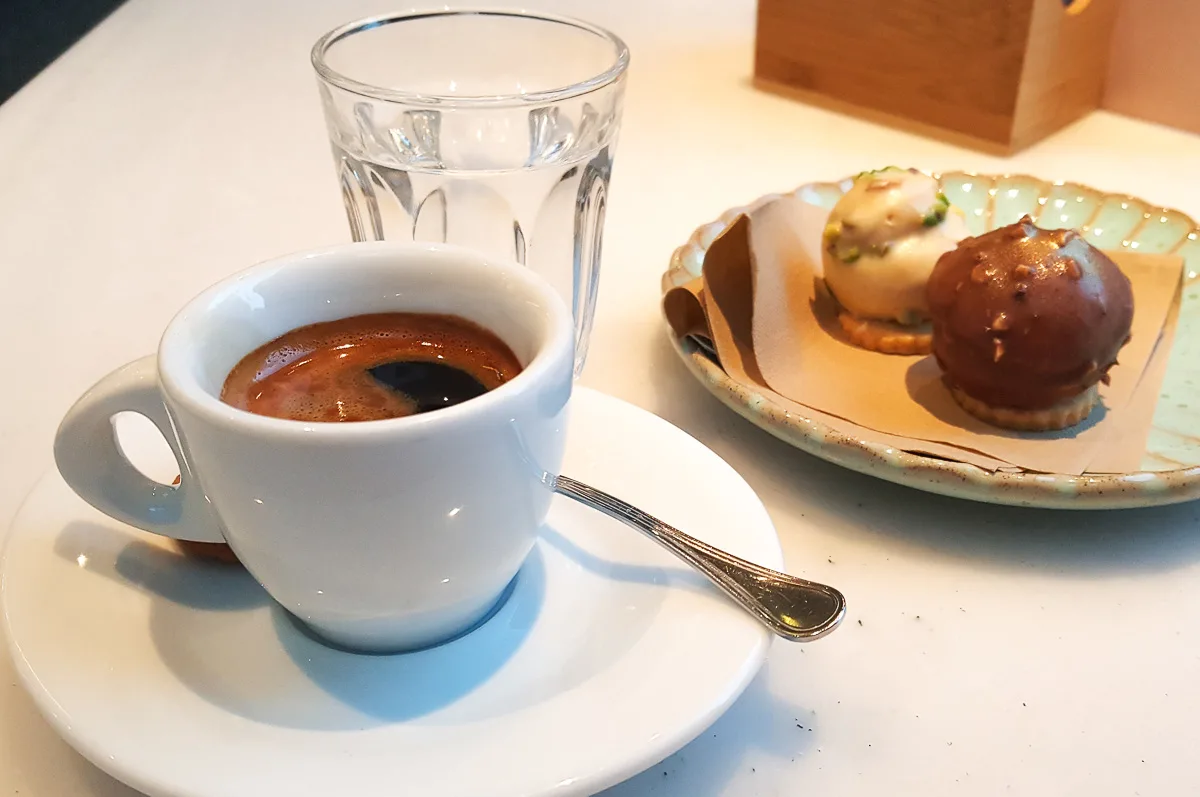
Fear not! In this blog post today I will give you the information that you need to navigate the long list of Italian coffee types like a true local. It’s everything that I’ve learned over my 15 years of regularly travelling to Italy (six of which I spent actually living there). It’s precious knowledge based on hundreds of cups of caffè each of which I truly enjoyed drinking.
Take it from me, ordering coffee in Italy is not difficult and it’s a great way to have a truly authentic Italian experience. To help you, this blog post gives you 21 of the most popular types of coffees in Italy. Knowing what each one of them stands for will help you choose the coffee drinks that you want to savour during your Italian holiday.
If you want to delve deeper into the history and the rules of the Italian coffee culture, then also have a look at these two blog posts:
- Coffee in Italy or 101 Facts about Italian Coffee Culture
- 19 Rules of Italian Coffee Culture or How to Drink Coffee Like an Italian
Now, on this page here, we will concentrate specifically on the types of Italian coffees. This way you won’t need a menu when it’s time to order a coffee in a bar in Italy.
Have a look!
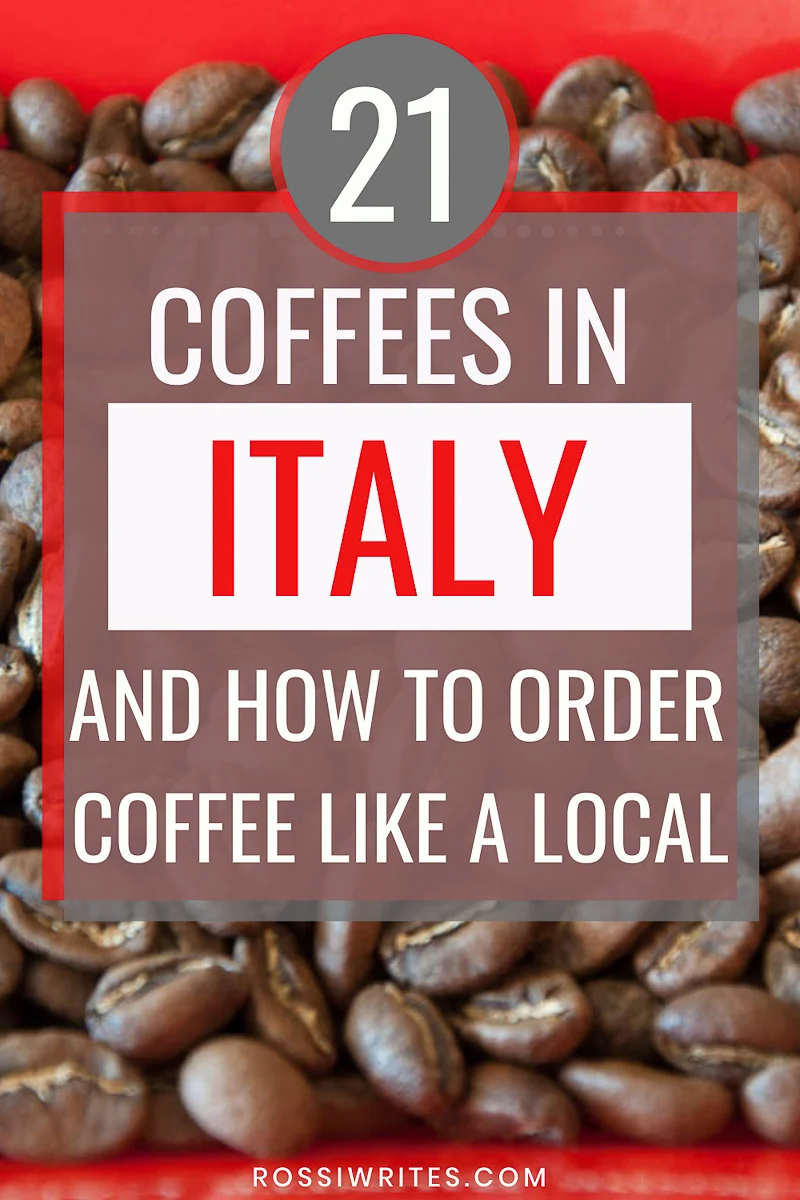
21 Types of Italian Coffees and How to Order Coffee in Italy Like a Local
1. Caffè (Espresso)
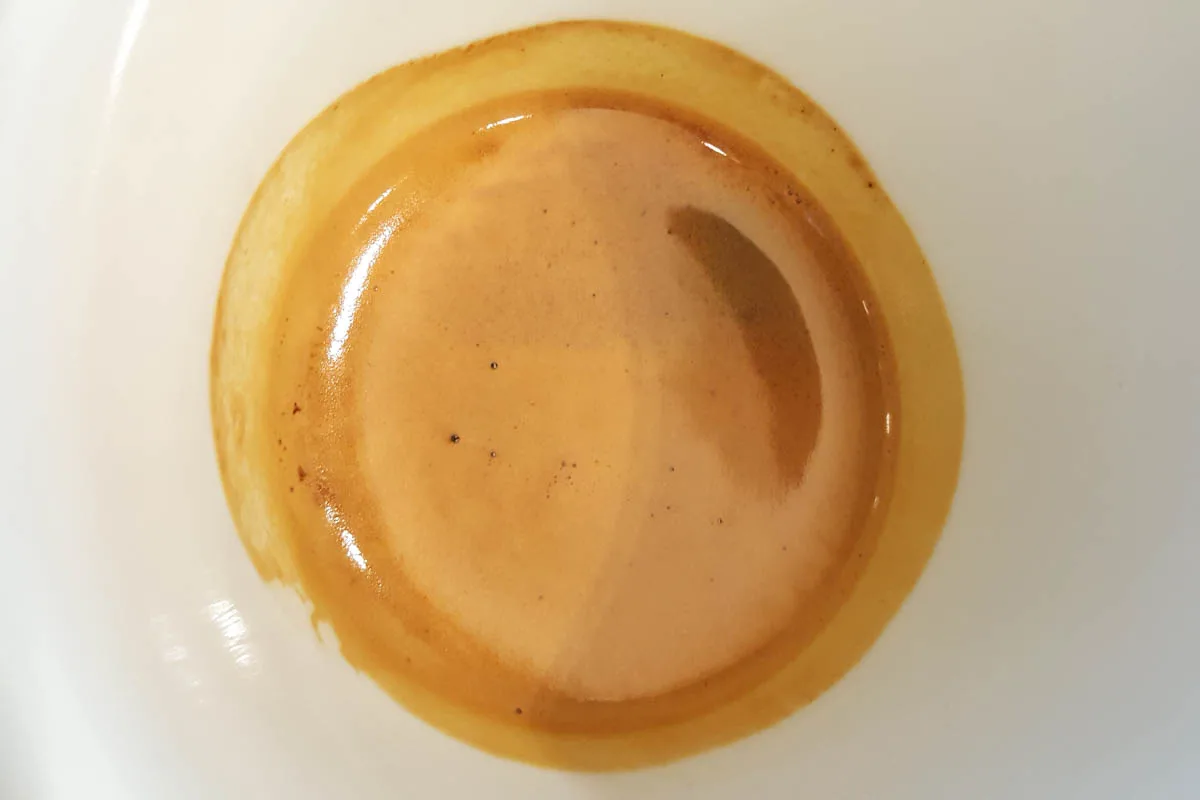
Asking for un caffè in Italy is equivalent to ordering an espresso anywhere in the world. This is the typical base coffee drink. Most of the Italian coffee drinks listed below start life as an espresso to which milk, cream, and/or other extras are added.
Even the smallest bars in Italy traditionally have a state-of-the-art coffee-making machine and serve excellent caffè (espresso) with a beautiful fragrant crema on top. A crema is the natural layer of coffee oils that forms on top of the espresso thus giving it its intense and irresistible flavour.
The dose for a perfect espresso is 7 gr. The pressure of the coffee-making machine should be between 15 and 18 atmospheres and the pressure of the water inside it – about 9 atmospheres. The temperature of the water should be between 88 and 95 degrees Celsius and the temperature of the espresso – between 78 and 82 degrees Celsius straight from the machine.
The ideal extraction time is 30 sec (+/-5). The resulting fragrant liquid should be 25-30 mil. Espresso traditionally is served in a slightly flared at the top and warmed-up cup (35-40 degrees Celsius). For maximum enjoyment, a cup of espresso should be drunk within 2 minutes of having been made.
So, to recap. If you want to order an espresso when you are in Italy, the Italian thing to say is un caffè. If by the force of habit you say un espresso instead, don’t worry too much. It took me a long time to get out of the habit of saying un espresso and to start saying un caffè. Baristas were very understanding. Just never ask for ‘un expresso’. While some experts argue for the linguistic right of the anglicised term expresso to exist and to be used, it never sounds right when in Italy.
2. Ristretto
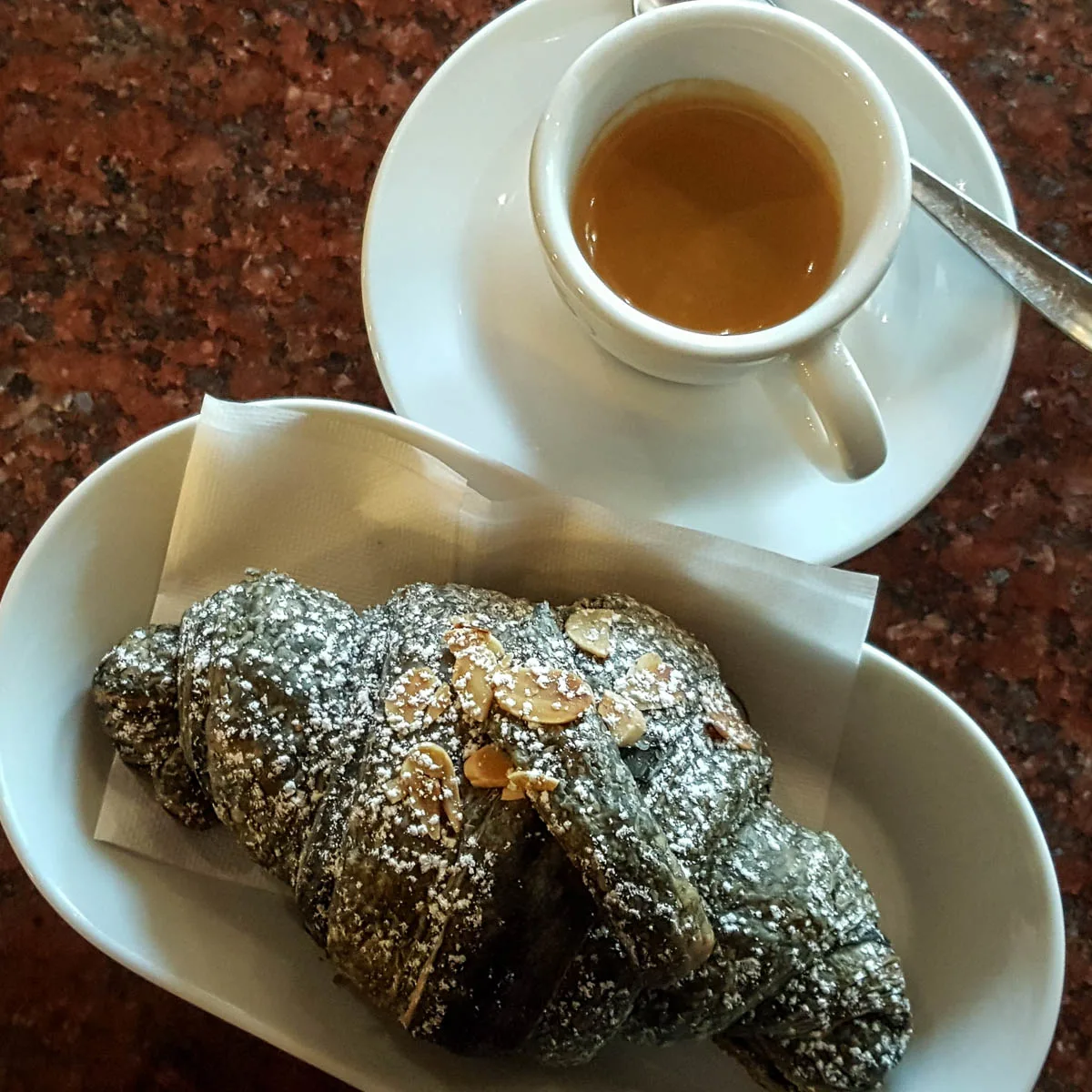
Ristretto in Italian means literally restricted or limited in English. So, un caffè ristretto is an espresso made with the same amount of coffee grounds but about half the water used for a cup of espresso. The result is a very strong and concentrated drink that provides a powerful caffeine hit. With a dark chocolate colour and an intense flavour, a ristretto gives you a good kick in the moments when you most need it.
3. Caffè lungo (Long Espresso)

Caffè lungo is a single shot of espresso prepared with more water. You can actually specify how lungo you want it. With just a bit of extra water or with double the amount of water if at a particular moment you fancy a slightly less strong caffè.
4. Caffè doppio (Double Espresso)
Caffè doppio is a double shot of espresso. So, expect double the amount of coffee grounds and water. As the Italian caffè is very strong and fragrant as it is, it is rare for people to order un caffè doppio here. Traditionally, they simply have a caffè as it is and then later on during the day have another one again.
5. Caffè decaffeinato (Decaffeinated Coffee)
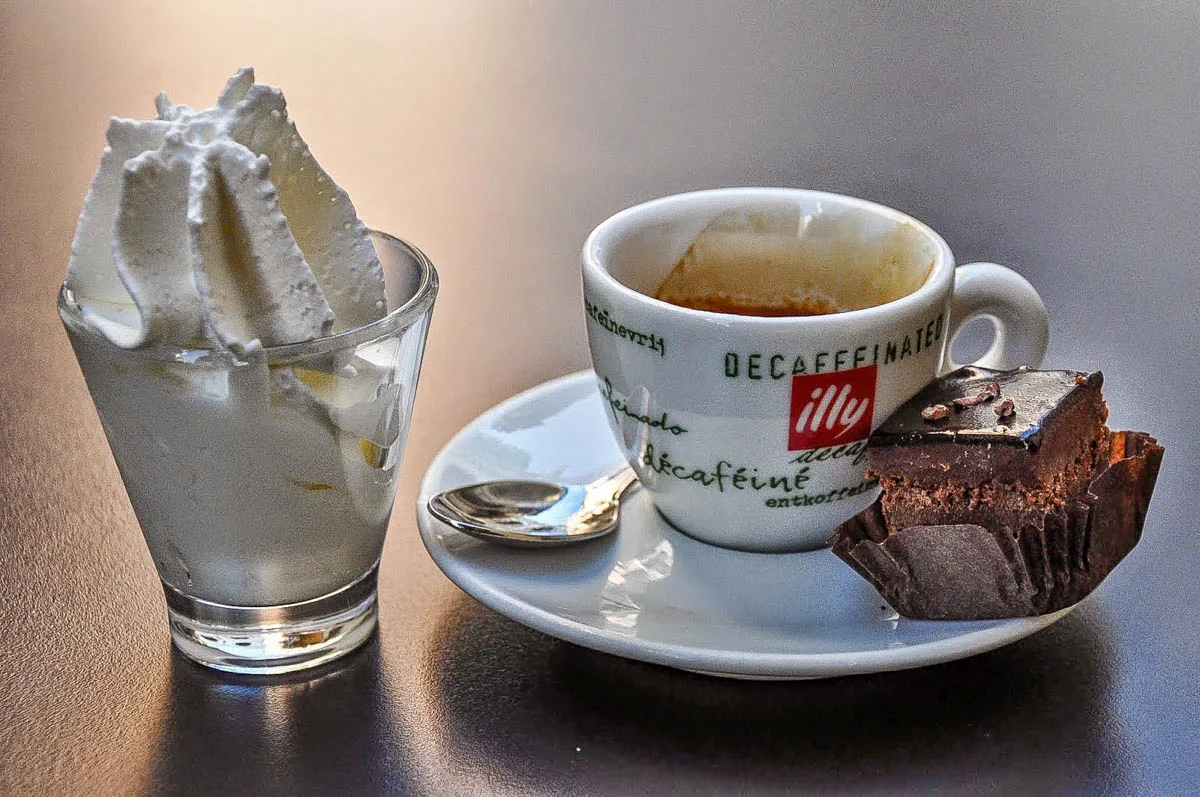
A caffè decaffeinato is just what it says on the tin, namely – decaffeinated coffee. If you want one in Italy, then don’t worry. No one is going to look at you strangely or bat an eyelid. Caffè decaffeinato is widely available here. To be more local, ask simply for un caffè deca.
You can have your caffè deca in the same versions as a full caffeine espresso, i.e. ristretto, doppio, and lungo. Or, you can opt to have your cappuccino, macchiato, macchiatone, marocchino, and so on made with caffè deca.
6. Cappuccino
Cappuccino is an Italian coffee drink that nowadays is loved and appreciated all over the world. It’s prepared by adding steamed milk on top of a shot of espresso and finishing it all off with milk foam. The ratio of the three ingredients is more or less 1:1:1. Bear in mind that in Italy the cappuccino is served in a much smaller cup than the sizes used by the large multinational coffee chains. As such, the real Italian cappuccino is flavoursome, intense and satisfying.
When in Italy, you can order a cappuccino chiaro or a cappuccino scuro. The former is prepared with less coffee and the latter with more coffee. Hence one is lighter in colour (in Italian, chiaro) and the other is darker (in Italian, scuro).
Another Italian variation is the so-called cappuccino secco. It literally means dry cappuccino and it’s prepared only with espresso and milk foam thus omitting the hot milk completely.
You can also ask for your cappuccino to be prepared with cold instead of steamed milk.
7. Macchiato
Macchiato in Italian means literally spotted or stained in English. So, un caffè macchiato is an espresso with just a touch of milk. The milk traditionally is steamed and frothy. You see it forming a tiny little island in the middle of your coffee cup with the fragrant crema of the espresso surrounding it on all sides.
When in Italy, you can order a macchiato caldo or a macchiato freddo. The first is a macchiato with a touch of hot milk and the other is a macchiato with a touch of cold milk.
8. Macchiatone
Macchiatone is a large size caffè macchiato. In Italian, -one is an augmentative suffix. By adding it to the noun we make it bigger and larger.
Just like macchiato, macchiatone is prepared with a single shot of espresso. However, the quantity of steamed, frothed milk added to it is much larger. This is more of a regional type of coffee in Italy. It is especially popular in the Northern Italian region of Veneto. As I lived in Vicenza – a beautiful small city in the Veneto – for six years, I became quite closely acquainted with macchiatone. Hence, I have included it as a separate entry in this list of Italian coffees rather than in the entry ‘Regional Italian Coffee Drinks’ under number 21 below.
Go to any bar in Vicenza in the morning and you will see that macchiatone here is ordered more often than cappuccino.
9. Caffè con panna (Espresso with Whipped Cream)
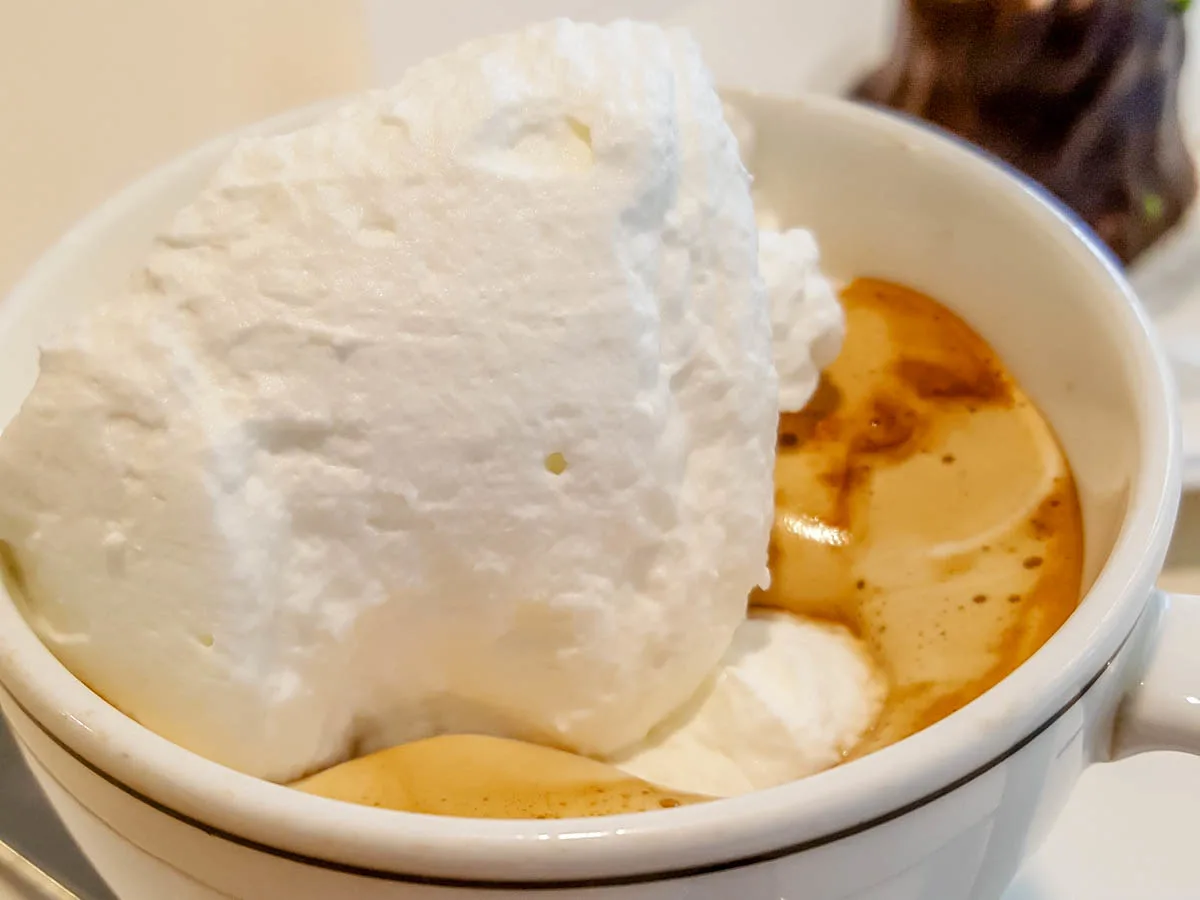
Caffè con panna in Italy is a shot of espresso served with a large blob of whipped cream spooned on top of it. This is my favourite type of coffee to order in Italy. However, it’s best to have it in an Italian patisserie (called pasticceria in Italian). This is where they whip the cream on-site and you will be presented with the smoothest, richest, most generous blob of freshly whipped cream to mix with your caffè and truly indulge in.
In case you are in an Italian bar and you want to order a caffè con panna, first ask if the cream is freshly whipped or if it is from a spray. If the latter, then order something else.
10. Marocchino
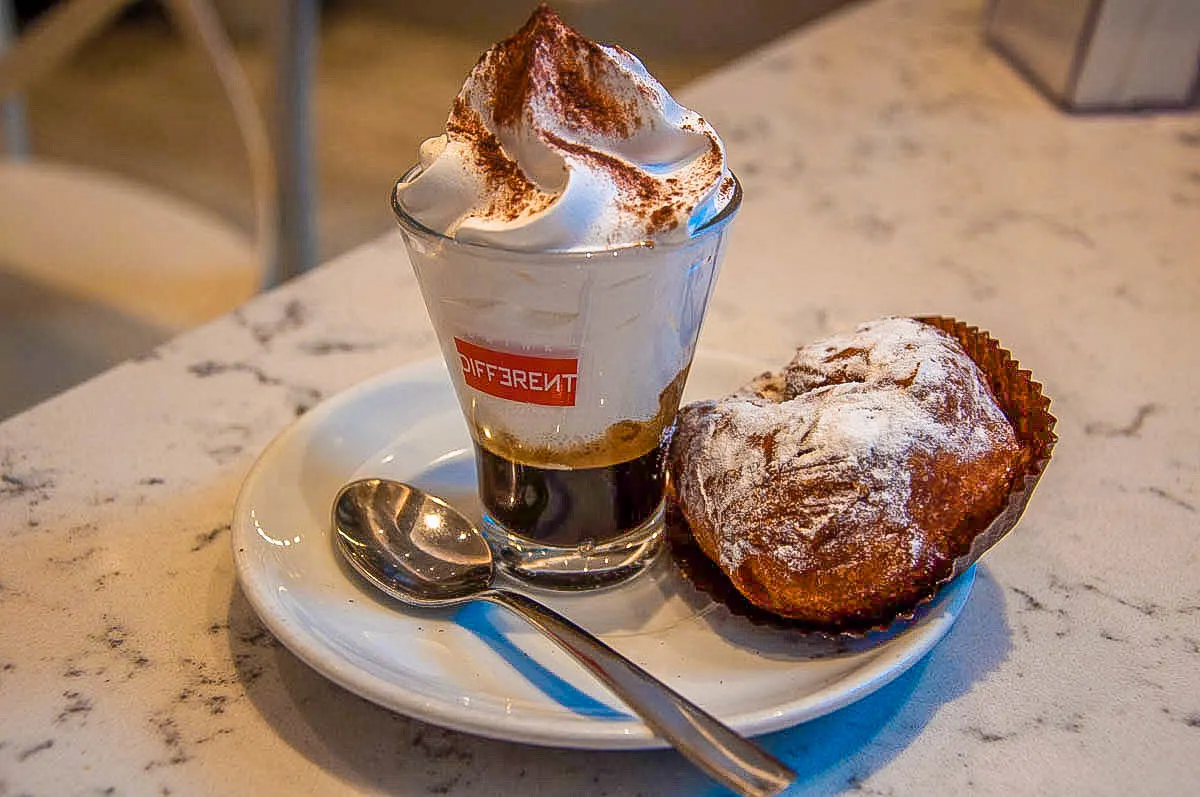
Marocchino is a type of Italian coffee the light brown colour of which is reminiscent of Morocco leather. Hence its name – marocchino – which is the Italian word for it.
Typically, marocchino is prepared by first adding a layer of unsweetened cocoa powder to a shot of espresso and then topping it all up with full-fat milk whipped into cream. Traditionally, marocchino is served in a small glass which is also dusted with cocoa powder. However, nowadays there are many regional and local varieties of marocchino all across Italy. In some places in Northern Italy, a dash of hot chocolate or a spoonful of chocolate spread is added to it. In other places, marocchino is known under different names. For example, in Regio Calabria, they call it Venezia (which is the Italian name of Venice).
Marocchino was first invented in 1929 in the historic coffee house Caffè Carpano (no longer existing) in the city of Alessandria in Piedmont, Northern Italy. At the time, the famous Italian hats Borsalino were being made in a factory just across the road. They say that the drink with its thin layer of cocoa powder in the middle got its name from the leather strip running on the inside of a Borsalino hat which was called exactly marocchino.
11. Caffè corretto
Corretto in Italian means literally correct or proper in English. So, un caffè corretto is a shot of espresso with a shot of liquor added to it. Traditionally, it could be a shot of grappa or a shot of sambuca. However, it depends on where in Italy you are and thus on the local liquor preferences.
12. Americano

Yes, you can order un caffè americano in Italy. I have done it several times. It was my go-to coffee drink on the mornings when I wanted to soften a bit the caffeine hit offered by a proper Italian caffè.
The difference between an Americano served in Italy and an Americano served anywhere else is that in Italy this coffee drink has two components:
- espresso served in a larger cup; and
- a small jug of hot water for you to top up the espresso with as much or as little water as you personally like.
I have never seen an Americano served with milk in Italy though. If you simply must add milk to your Americano here, then order a small glass of latte (which, literally, means milk in Italian) and then add it to your coffee as you see fit.
13. Caffè latte (Latte)
Asking for un caffè latte in Italy is equivalent to ordering a latte anywhere in the world. Be aware that latte means simply milk in Italian. So, if you order just a latte, most likely you will be served a glass of milk with no coffee in sight. A caffè latte is basically one part espresso, two parts hot milk, and just a little bit of milk foam.
14. Mocaccino
Mocaccino is a decadent Italian coffee drink made of cappuccino, whipped cream or milk froth, and chocolate. It can also be sprinkled with cocoa powder. Sometimes, alcoholic chocolate liquor is used, too. Mocaccino is always served in a glass. This way, you can appreciate better the different layers of the drink before mixing them up for maximum flavour and taste.
15. Caffè d’orzo (Barley Coffee)
Orzo in Italian means barley in English. The Italians have been making hot coffee-like drinks from roasted barley for decades. At times when real coffee was too expensive or was missing from the market, caffè d’orzo filled the gap. Nowadays and with real coffee everywhere in Italy, caffè d’orzo remains very popular here, too. You can order it in many different shapes – from espresso to cappuccino and macchiato – in any Italian bar.
Caffè d’orzo doesn’t have any caffeine. Hence, it is also offered to kids in Italy and many Italians start their lifelong love affair with coffee by drinking hot coffee-like barley drinks first.
16. Caffè al ginseng (Coffee with Ginseng Root Extract)
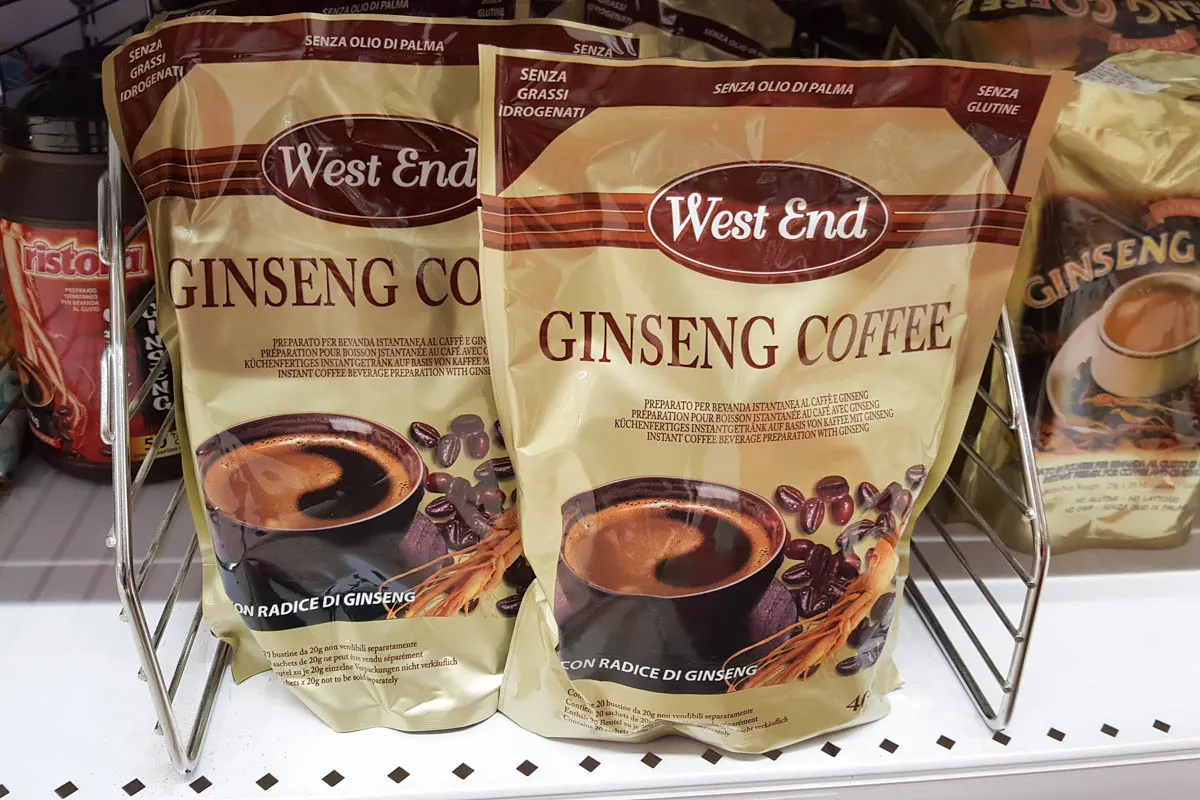
Caffè al ginseng is a hot drink prepared with ginseng root extract mixed with coffee. It has a sweet nutty flavour and it can be a very nice and mellow alternative to the kick that a strong Italian espresso provides.
Again, you can ask to have your cappuccino or macchiato prepared with caffè al ginseng if you wish. You can also buy both caffè al ginseng and caffè d’orzo in Italian supermarkets and use them at home.
17. Caffè shakerato
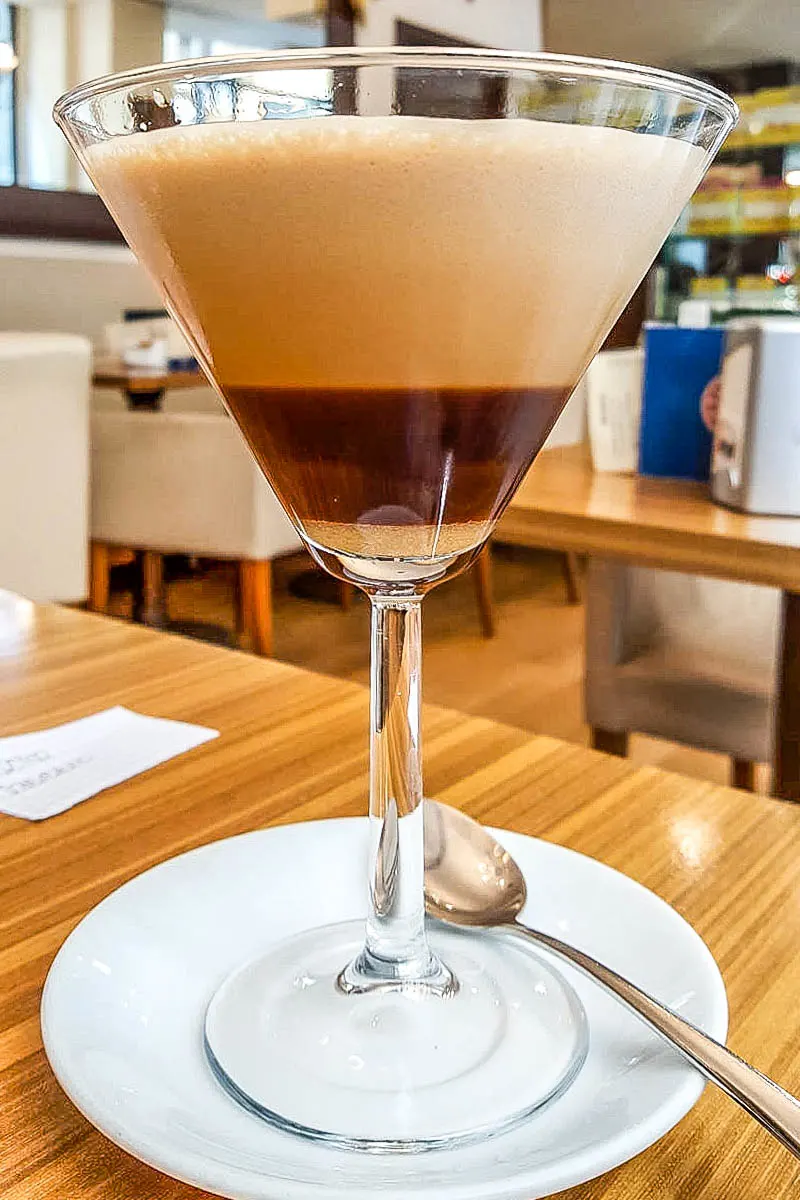
Caffè shakerato is a very elegant Italian coffee drink. It is very popular in summer and it is customarily served in a tall glass. It has a very nice thick froth and it is light and uplifting to drink. It is made by shaking together a long shot of strong espresso and ice. For this, a metal shaker is used. It’s very similar to how you make a cocktail.
When you order a caffè shakerato in an Italian bar, you will be asked if you want it dolce (hence sweet, in which case sugar will be added) or amaro (hence bitter). Sometimes, instead of dolce they use the word zuccherato (which means sweetened with sugar in English).
If you want to jazz up your caffè shakerato a bit, you can ask for whipped cream (panna) and/or chocolate to be added to it. Another option is to have it shaken with a shot of sweet liquor.
18. Crema al caffè
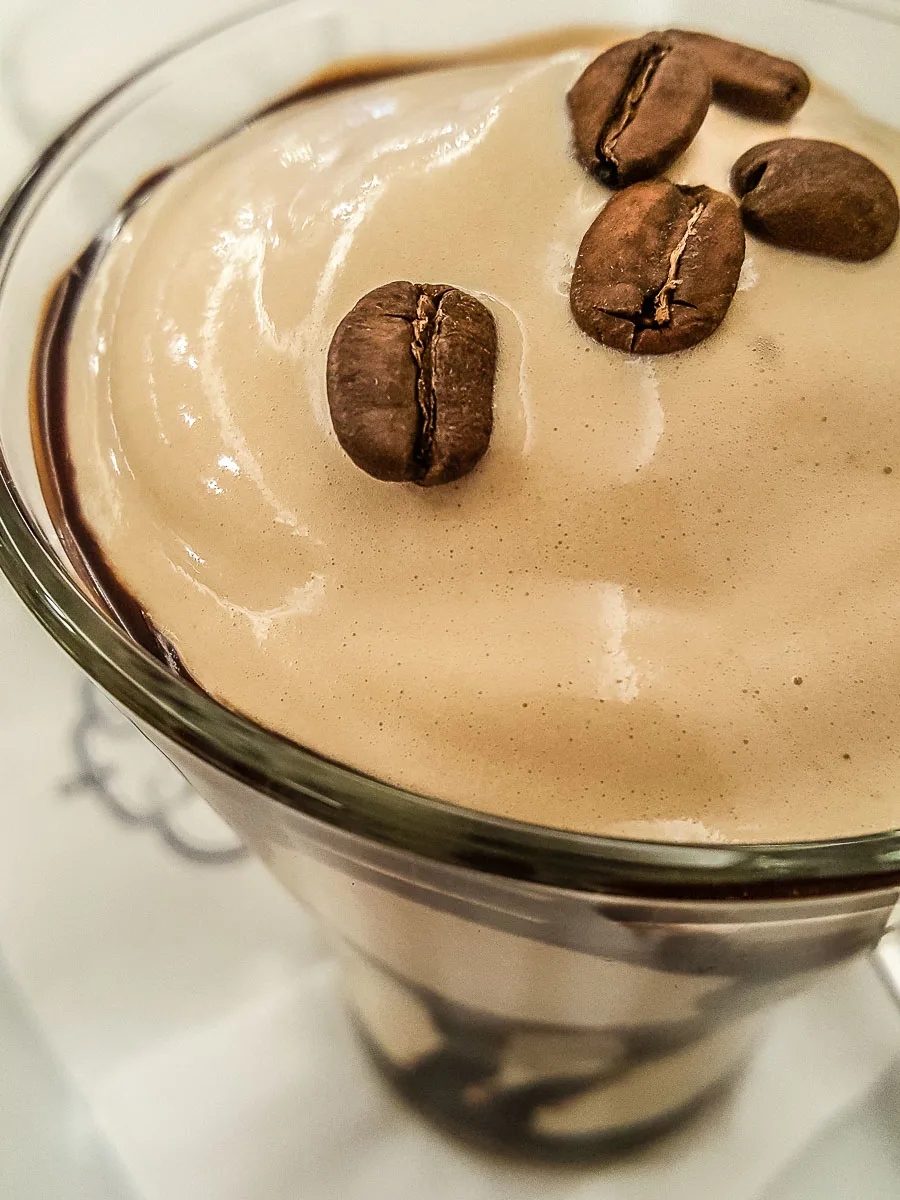
Crema al caffè is like a slush puppy for grown-ups. Basically, this is a frozen cream and coffee mixture which is slushed by a machine. As soon as the weather starts heating up, every self-respecting Italian bar loads up their crema al caffè machine and gets ready for business.
Crema al caffè is served in glasses, too and you can, ordinarily, order it in different sizes. It comes with a small spoon for you to scoop it out of the glass, as you can’t really drink it. It is more to be savoured bit by bit.
19. Caffè affogato
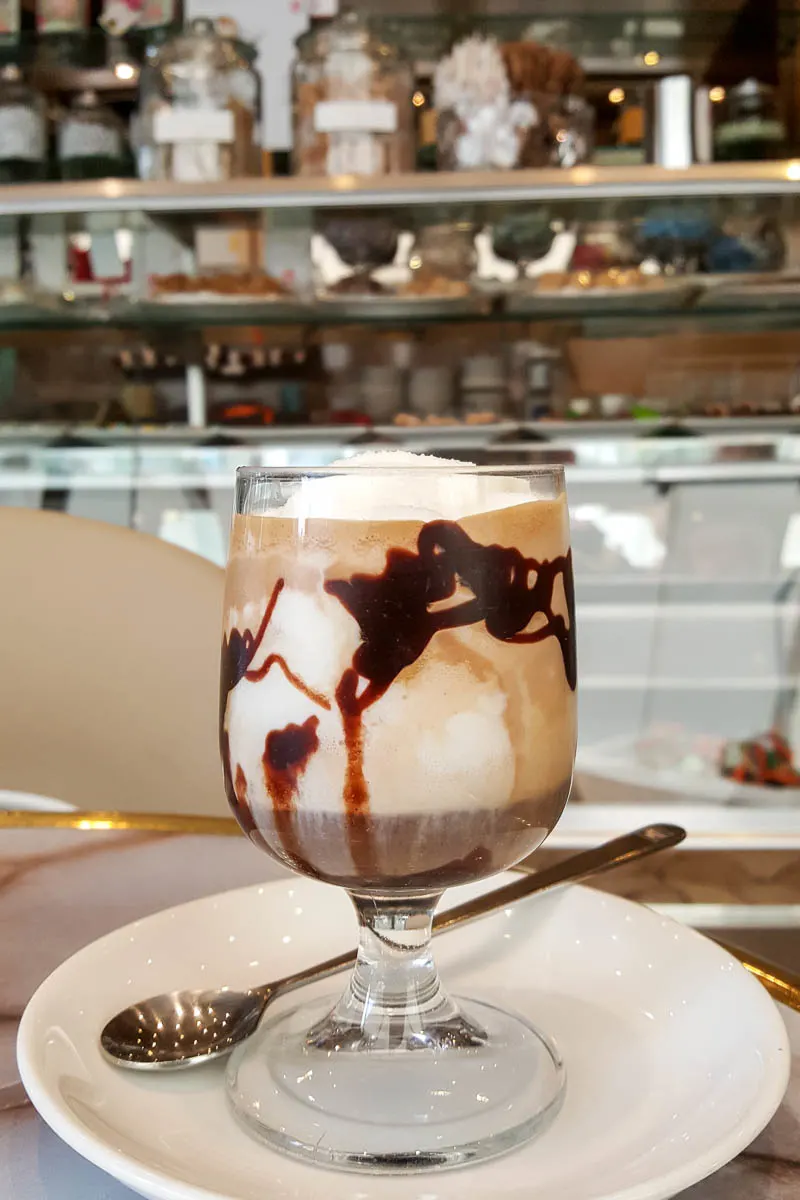
Caffè affogato in Italian means drowned coffee in English. This is so because it is prepared by placing a scoop of (traditionally, vanilla) ice cream in a glass and then pouring on top of it a shot of freshly made espresso. You can either mix the ice cream and coffee in a nice thick drink to savour or you can scoop your ice cream bit by bit with the coffee coating each bite. Caffè affogato is a simple, yet decadent Italian coffee drink. In summer, you can find it everywhere in Italy.
20. Moka
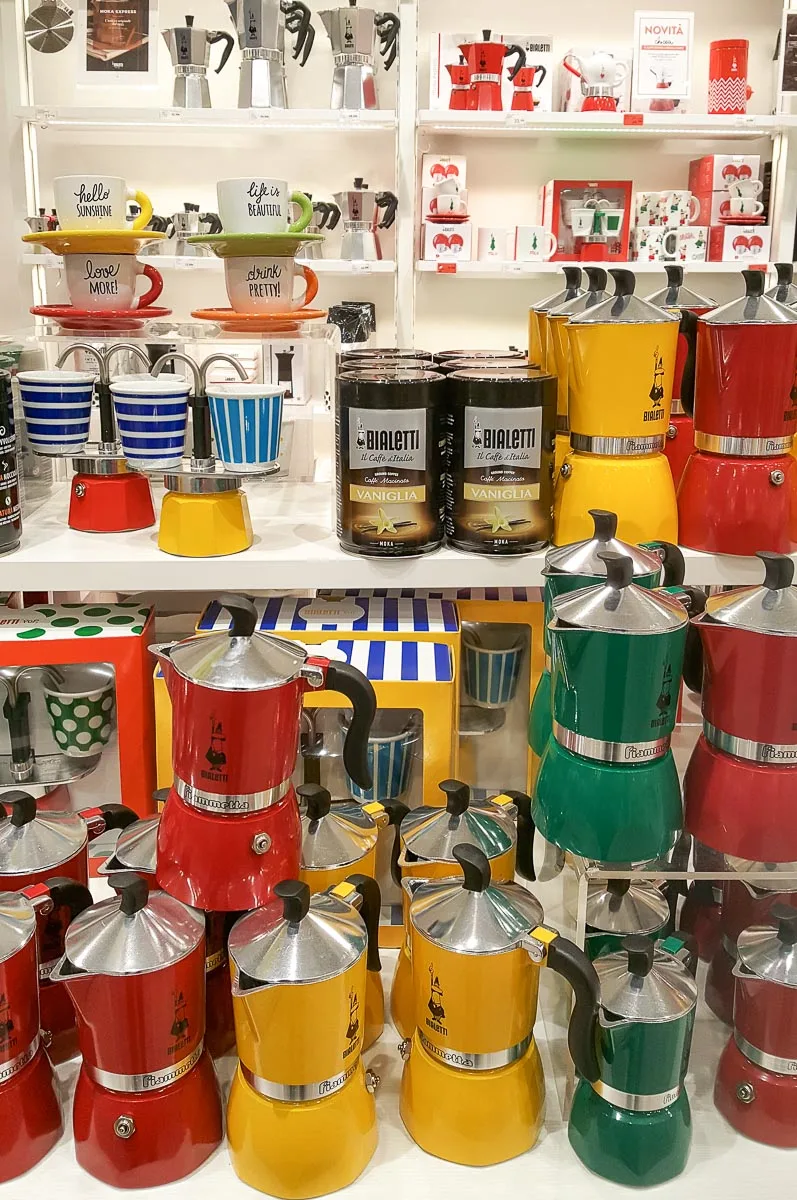
Moka is Italy’s traditional coffee pot. It was invented by Angelo Bialetti and patented by him in 1933. A Moka has three parts – a bottom which you fill with water, a filter which you fill with ground coffee, and a top part which you screw to the bottom part with the filter in the middle. Then you put the Moka on the stove and remove it as soon as the hot coffee fills up the top part and you hear it starting to hiss. Don’t leave it to boil as this impairs the flavour.
Here is what an original Bialetti Moka looks like.
You can’t buy coffee made with Moka pot in an Italian bar. A Moka is strictly to be used at home. I have included it in this list of 21 types of Italian coffees for the simple reason that you will most likely come across a Moka during your stay in Italy. You may see your Italian host using one or you may see a shop selling a variety of Moka pots.
Moka is an intrinsic part of the Italian coffee culture. Using one is simple and it makes excellent strong coffee. So, getting a Moka pot yourself or at least making sure that you don’t leave Italy without trying a Moka coffee, is a great way to get to know Italy authentically.
21. Regional Types of Italian Coffees
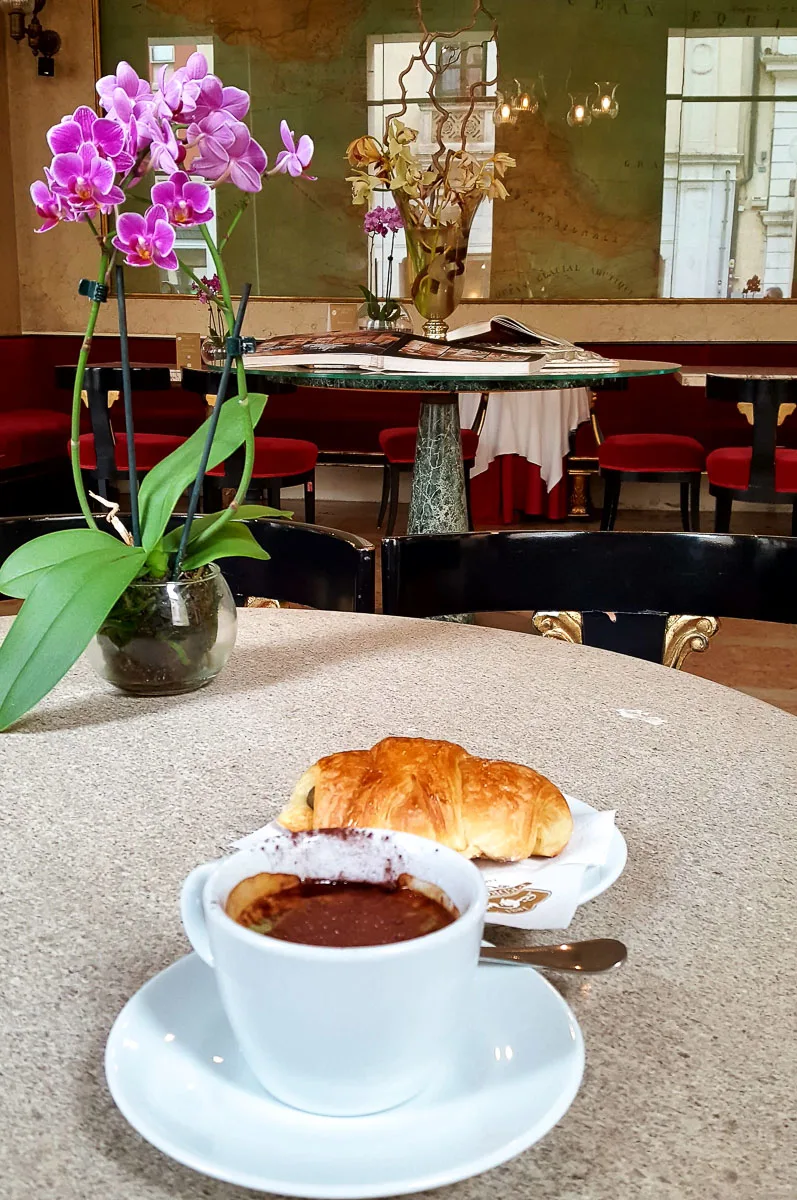
There are many types of Italian coffees that are typical only for a particular Italian place or region.
For example, in Padua – one of the largest cities in Veneto – they have their own very special coffee drink. It’s only made in the city’s historic coffee shop – Caffe’ Pedrocchi. The Pedrocchi coffee (pictured above) is a shot of 100% Arabica with mint syrup, whipped cream emulsion, and a dusting of bitter cocoa.
In Livorno – a city in Tuscany in Central Italy – they have a coffee drink called ponce. Its name comes from the term punch in English. It is prepared with sugar, lemon peel, rum (which can be mixed with cognac or sassolino – an alcoholic drink from the province of Modena), and ristretto.
In Turin – the capital of the Northern Italian region of Piedmont – they are very proud of their coffee-based drink bicerin. It’s made of espresso, hot chocolate, and milk which are layered one on top of another.
So, when you are in Italy, always ask to try the local coffee drink! It’s a great introduction to the little-known sides of Italian coffee culture.
In Conclusion
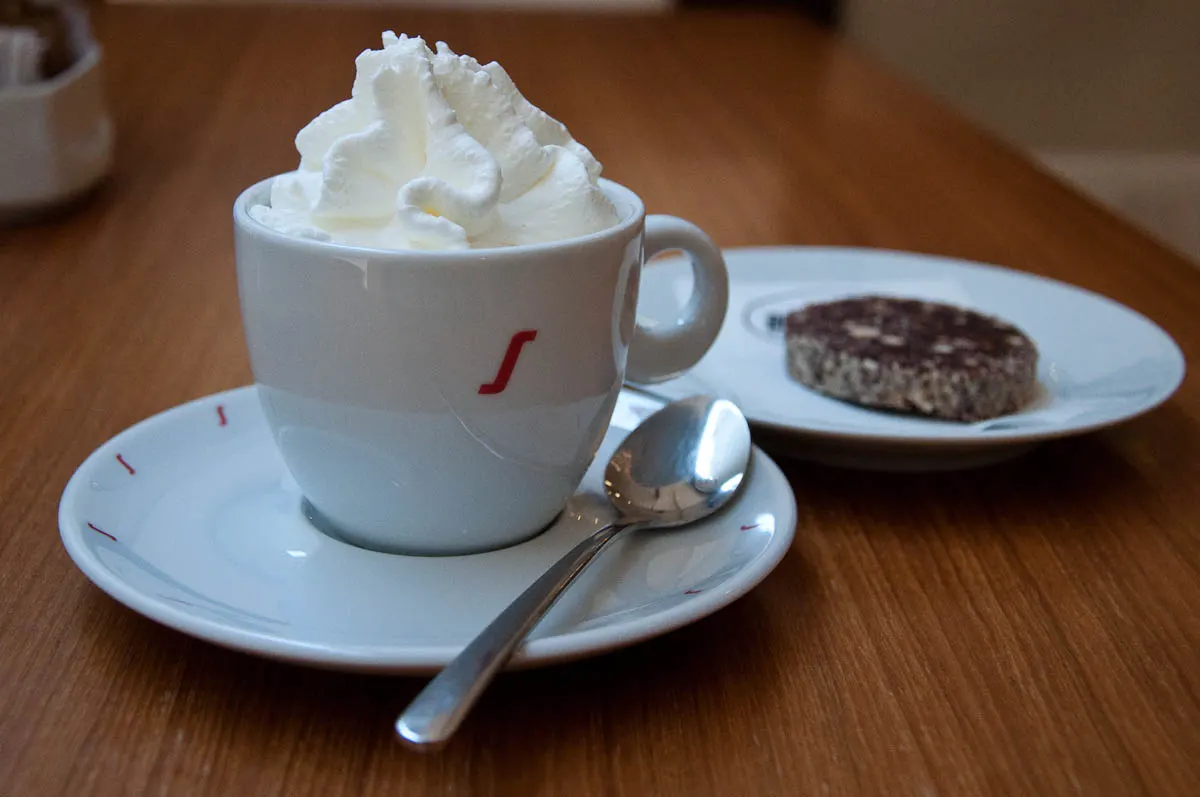
Italian coffee culture has largely defined how the world drinks coffee. Every day, billions of people grab a coffee drink with an Italian name and provenance. From espresso to cappuccino, our coffee vocabulary is mostly Italian.
So, you would think that ordering a coffee in Italy would be an easy task. After all, by now we all know what a latte is.
As it turns out, the Italian coffee scene has its own rules that have been honed to perfection throughout the centuries. Plus, the types of coffees one can actually order in Italy are not identical to what the large multinational coffee chains have led us to believe are Italian coffee drinks. Ordering a latte in Italy, for example, will get you a glass of milk rather than a milky coffee drink.
From marocchino to mocaccino and from affogato to shakerato, Italy has its own coffee drinks which are steeped in tradition. As for espresso and cappuccino, obviously, they are at the base of it all. However, once you have had them in Italy, it’s easy to spot the differences between the Italian original and the foreign approximations.
To make it easy for you to orient yourself in the Italian coffee scene, this blog post gives you a list of 21 traditional types of Italian coffees. For each one of them, a short paragraph is provided explaining how the drink is made and how to order it for the best Italian coffee experience.
I hope that the information herewith will help you enjoy the best coffees of your life during your visit to Italy!
Enjoy coffee in Italy!
Shop Italian Coffee
[mks_col]
[mks_one_third][/mks_one_third]
[mks_one_third][/mks_one_third]
[mks_one_third][/mks_one_third]
[/mks_col]
More Helpful Info for You About Coffee and Food in Italy
Coffee in Italy:Italian Coffee Culture, Cold Coffee Drinks, 101 Facts About Coffee
Breakfast in Italy: Italian Breakfast Foods and Drinks, Rules of Breakfast in Italy
Food in Italy: Cheap Food in Italy, Italian Cheeses, Traditions of Panettone, What is Polenta, Caperberries, Mandorlato Veneto, Venetian Fritella, Sant’Antonio Cakes, Making Prosciutto, Arrosticini, Tortellini, Cremino
Food Festivals in Italy: Chestnut Festivals, Truffle Festival, Cherry Festivals, Pea Festival, Prosciutto Festival, Chocolate Festival
Markets in Italy: Rialto Fish Market, Padua Market, Types of Markets
More Helpful Italy Info for You
Best of Italy: Italian Piazzas
Northern Italy: 18 Best Cities to Visit, Airports
Lake Garda: Best Towns, Nearest Airports, Travel Options, Lake Garda with Kids
Lake Como: Things to See, Nesso
Veneto: Best Cities to Visit, Top 15 Places, 30 Adventures, 15 Most Colourful Places
Friuli Venezia Giulia: Venzone, Most Beautiful Villages
Emilia Romagna: Bologna, Ravenna, Comacchio, Most Beautiful Villages
Marche: 6 Reasons to Visit, Gradara, Frasassi Caves, Temple of Valadier
Trentino: Cities and Towns in Trentino, Rovereto, Lakes in Trentino, Lake Caldonazzo
Venice: Essential Tips, Hidden Gems, Best Airports, Boats in Venice, Haunted Venice, Day Trips from Venice, Arco del Paradiso
Verona: Things to Do in One Day, Verona Opera Festival, Day Trips from Verona
Padua: Things to Do in One Day, 101 Facts About Padua, 10 Reasons to Visit Padua, Day Trips from Padua
Vicenza: Things to Do, Day Trips from Vicenza
Day Trips in Italy: Bologna to Verona, Milan to Verona, Venice to Verona, Bologna to Venice, Milan to Venice, Florence to Venice, Verona to Venice, Venice to Padua
Thank you for reading! Please, leave me a comment, pin the image below or use the buttons right at the top and at the end of this blog post to share it on social media.
For more useful information like this, please, like my blog’s page on Facebook and subscribe to my strictly no-spam newsletter.
[mks_col]
[mks_one_half] [/mks_one_half]
[/mks_one_half]
[mks_one_half]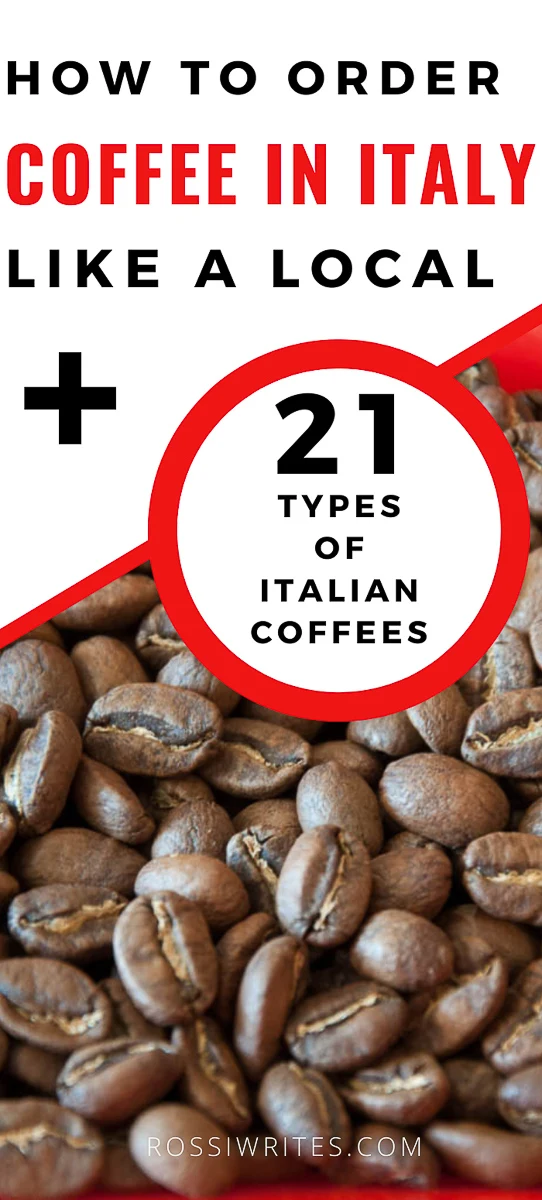 [/mks_one_half]
[/mks_one_half]
[/mks_col]



